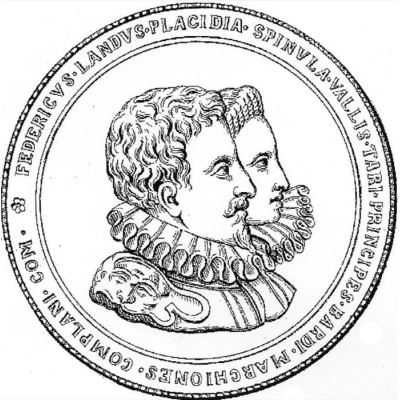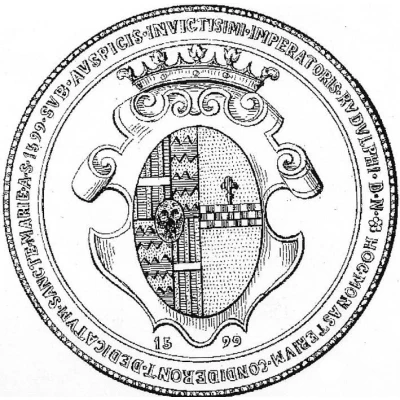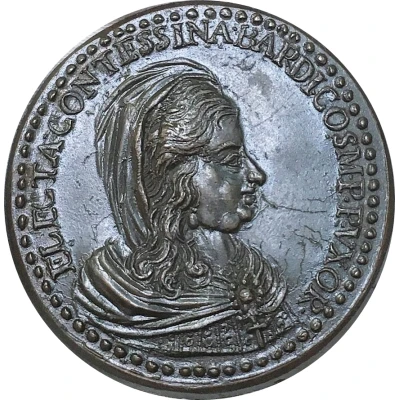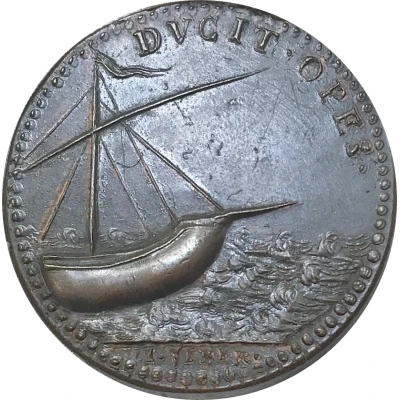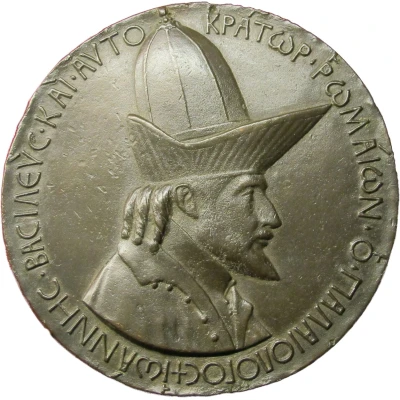
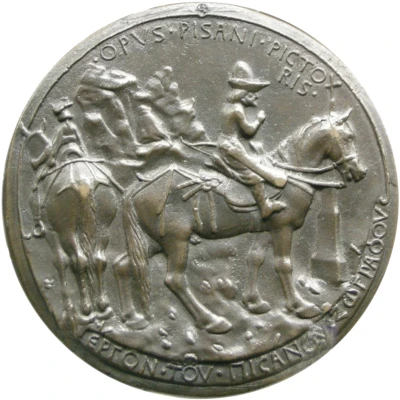

Medal - Visit of Emperor John VIII Palaiologos ND
| Bronze | 355 g | 101 mm |
| Location | Duchy of Ferrara (Italian States) |
|---|---|
| Type | Commemorative medals › Visit medals |
| Years | 1438-1439 |
| Composition | Bronze |
| Weight | 355 g |
| Diameter | 101 mm |
| Shape | Round |
| Technique | Hammered |
| Orientation | Medal alignment ↑↑ |
| Demonetized | Yes |
| Updated | 2024-11-14 |
| Numista | N#337851 |
|---|---|
| Rarity index | 100% |
Reverse
Byzantine Emperor John VIII Palaiologos on horseback, facing right, wearing domed hat, raising right hand, and holding bow and quiver of arrows to his right hip. To the left, mounted squire viewed from the rear. Both horses with elaborate straps over their hindquarters. Pedestalled wayside cross to the right. Rocky landscape in the background.
Scripts: Greek, Latin
Lettering:
• OPVS • PISANI • PICTO
RIS •
ἜPΓON • TÔV • ΠICÁNOV • ZΩΓPÁΦOV
Translation: Work of Pisani, the painter.
Engraver: Pisanello
Comment
This medal is considered the first portrait medal of the Renaissance [1 page 10; 2 page 25; 3 page 45]. The medal left a significant impact on art, beyond numismatics, influencing sculptors and painters such as Piero della Francesca, who used the image of the emperor in his Flagellation of Christ and Arezzo frescoes [1, page 28].
The medal may have been commissioned by the Emperor John VIII or by Leonello d’Este, the heir apparent to the Marquisate of Ferrara [3, page 46]. The exact date of the medal is not known, but it was likely made while the emperor was in Italy, between March 1438 and July 1439. It is more likely to have been made in Ferrara rather than in Florence. This is supported by a letter dated 12 May 1439, in which Pisanello is promised payment from a church in Mantua, near Ferrara [4, page 14].
The council of Ferrara
The reverse illustrates the arrest of a hunting expedition in Italy, when Emperor John VIII encountered a pedestalled wayside cross. The Byzantine emperor visited Italy to attend the council of Ferrara. Pope Eugenius IV wanted to address the question of unifying the Latin and Greek Christian churches. To encourage Emperor John VIII to attend the council, the pope offered to pay the expenses of the Byzantine delegation. However, the pope found this offer extremely difficult to honour, particularly because the emperor's entourage numbered circa seven hundred.
Emperor John VIII wanted to secure help from the western powers with the constant threat from the Ottomans [3, page 46]. The emperor arrived in Venice in February 1438, where he was welcomed by Niccolò III d'Este, Marquis of Ferrara. Niccolò, together with his sons, Leonello and Borso, accompanied the emperor to Ferrara on 4 March. The council opened on 9 April 1438 with a magnificent public session. Immediately after, the council was postponed to 8 October. The emperor stayed in Italy and relocated outside Ferrara due to an outbreak of plague in the city. During his wait, he showed little interest for ecclesiastical affairs and spent most of his time hunting. It is reported that his intense hunting activities damaged the local game population and surrounding properties, and the Marquis had to intervene [2, page 28]. In January 1439, the Council relocated to Florence, upon the invitation of Cosimo de' Medici. In Florence, a decree of union was signed in July 1439. However, when the Byzantine delegation returned to Constantinople, the union was strongly rejected by the Orthodox clergy and never took effect.
Maltaper (CC BY-SA 4.0)
Pisanello's sketches of John, held in Paris and Chicago, include inscriptions in Italian that describe the emperor's attire: The hat of the emperor should be white on top and red underneath, the profile black all around. The doublet of green damask, and the mantle of top crimson. A black beard on a pale face, hair and eye-brows alike [6, page 38]. The horse in the sketches is very likely to have come from a Byzantine stable because of its slit nostrils, typical to some oriental countries
References
[1] Roberto Weiss; 1966. Pisanello's Medallion of the emperor John VIII Palaeologus. British Museum, Oxford, United Kingdom.
[2] Lisa Jardine and Jerry Brotton; 2000. Global Interests : Renaissance Art Between East and West. Reaktion Books, The University of Chicago, United States.
[3] Stephen K. Scher; 1994. The Currency of Fame: Portrait Medals of the Renaissance. Harry N Abrams, New Yourk, United States.
[4] Mark Jones; 1979. The Art of the Medal. British Museum, London, United Kingdom.
[5] Michael Vickers; 1978. Some Preparatory Drawings for Pisanello's Medallion of John VIII Palaeologus. The Art Bulletin, volume 60, number 3, pages 417–424.
[6] James A. Fasanelli; 1965. Some Notes on Pisanello and the Council of Florence. Master Drawings, volume 3, number 1, pages 36–47.
